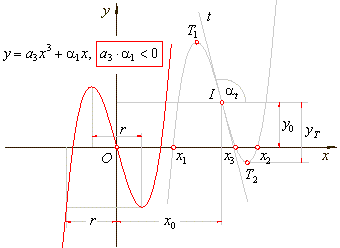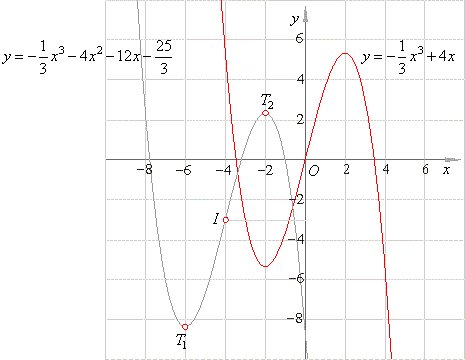|
 Cubic functions
Cubic functions |
 There
are three types of the cubic functions - the classification
criteria diagram
There
are three types of the cubic functions - the classification
criteria diagram |
|
The graphs
of the source cubic functions |
 Translated
cubic functions
Translated
cubic functions |
|
Translated
cubic function the type 2/2 |
|
Graphing a cubic
function type
2/2 example |
|
|
|
|
|
|
| |
| The
graphs
of the source cubic functions - the classification criteria
diagram |
|
|
|
| Translated
cubic function type
2/2 |
| type
2/2 |
y
=
a3x3
+ a2x2
+ a1x
+ a0 or
y
-
y0
= a3(x
-
x0)3
+ a1(x
-
x0),
a3
· a1
<
0, |
|
 |
 |
| If
| y0
| > | yT
| |
 |
| if
| y0
| £
|
yT
| |
 |
|
 |
|
The turning points |
 |
The
point of
inflection
I(x0,
y0). |
|
|
|
|
|
|
|
| Graphing a cubic
function type
2/2 example |
| Example:
Given is cubic function y
=
(-1/3)x3
-
4x2
- 12x
- 25/3,
find its source or original function and calculate the coordinates of translations, the zero
points, the turning points and the point of inflection. |
| Draw
graphs of the source and the given cubic. |
| Solution:
1)
Calculate the coordinates of translations
|
 |
|
y0
= f
(x0)
=> y0
= f (-
4)
= (-1/3)
· (-
4)3 -
4 · (-
4)2
- 12
· (-
4)
- 25/3 =
-
3,
y0
= -
3. |
| Therefore,
the point of inflection I(-
4, -
3). |
| 2)
To
get the source cubic function, plug the coordinates
of translations into the general
form
of the cubic, |
| y
+ y0
=
a3(x
+
x0)3
+ a2(x
+
x0)2
+ a1(x
+
x0)
+ a0 thus, |
| y
-
3
= (-1/3)
·
(x
-
4)3
-
4(x
-
4)2
- 12(x
-
4)
- 25/3,
y
=
(-1/3)x3
+
4x
the source
function. |
| As,
a3
< 0
and a3a1
< 0
given cubic is the type 2/2 whose graph is reflected around the x-axis. |
 |
the function has three real zeroes, |
|
|
 |
| By
plugging the coefficients of the source function and the
coordinates of translations
x0
and y0
we calculate the turning points, |
 |

|
|
|
|
|
|
|
|
|
|
|
|
|
|
| Functions
contents C |
|
 |
|
| Copyright
© 2004 - 2020, Nabla Ltd. All rights reserved. |